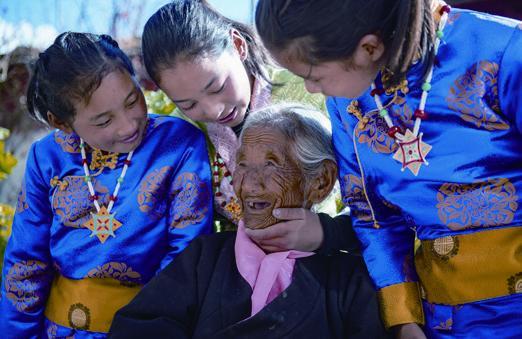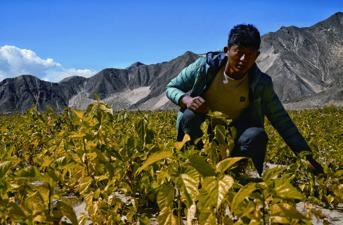A HISTORIC LEAP
2020-09-16ByLiNan
By Li Nan



When Polish-born Chinese jour- nalist Israel Epstein went to Lhasa for the founding of Tibet Autonomous Region in 1965, there were only a few special flights to the Roof of the World, mostly by veteran military pilots. And it was a no-fly zone for helicopters due to the bad weather and complicated terrain.
But 55 years later, Tibet has 120 regular domestic and international air routes and dozens of ethnic Tibetan civil helicopter pilots. In 2018, 23-year-old Gyatso became the first ethnic Tibetan civil helicopter pilot in China thanks to a free training program offered to youngsters from impoverished families.
A dream come true
One of four children born into a farmers family in Lhasa, Gyatso had never thought he could ever become a pilot. The opportunity came in 2016, when it was decided to build a civil helicopter base for sightseeing and emergency rescue in Lhasa as part of a program to assist Tibets development. Local pilots and maintenance personnel were needed for the base and the Lhasa City Government teamed up with Ruoer General Aviation Development Group(RGAD), one of the earliest private companies engaged in aviation and airport construction in China, to offer free training to 28 candidates.
Gyatso, then a senior computer major at Tibet University, passed the selection test and was signed up to learn flying in RGADs training base in the eastern province of Jiangsu. “I just couldnt believe it. I learned from the Internet that the training fee for a pilot is more than 1 million yuan ($146,252). How could that happen to me?” Gyatso said.
In 1994, the central authorities launched a pairing assistance program under which some developed provinces and municipalities were asked to help specific cities and counties in Tibet. Since then, Beijing and Jiangsu have been working with Lhasa, with poverty alleviation as their common objective. Building a civil helicopter base and assembling a local pilot team in Tibet were part of that.
After one years training, Gyatso became a qualified helicopter pilot and in 2018, got a job at the newly founded Lhasa Snow Eagle General Aviation Co. His starting salary was 12,000 yuan ($1,755). “I am the major breadwinner in my family. I take care of the family expenses, including my younger brothers tuition, so that my parents dont have to work too hard,” he said. “I have bought a car. My life is getting better and better.”
By July, Snow Eagle General Aviation had more than 150 employees, 80 percent of them Tibetans. Among them, 28 are from poor families.
A greener plateau
“More than three quarters of Tibet is above the tree line and grows no crops, only grass,” Epstein wrote in his book Tibet Transformed, based on his three journeys there in 1955, 1965 and 1976.
He passed away in 2005 but had he been alive today, he might have liked to add a new chapter. Thanks to a vigorous greening movement in Tibet, there are now trees flourishing in high altitudes.
Planting trees in Nagqu, a city in north Tibet with an average altitude of 4,500 meters above sea level, was thought to be mission impossible. The local authorities offered a cash reward to anyone who could grow a tree but there was no one to claim it even though the money was increased to 100,000 yuan ($14,625) in the late 1990s. Twelve years ago, Nagqu was still the only city in China without a single tree.

The turning point came in 2008. The local forestry authorities managed to keep alive 14 draught-tolerant trees, brought from outside, thanks to improved planting technology. Since then, over 32,000 seedlings of different varieties have been planted in Nagqu, including the salix alpina, the alpine willow, according to a report by Tibet Daily.
“Salix alpina can adapt to survive the high altitude of north Tibet,” Tsering, an associate professor at Tibet University, said. “Once the extensive planting trial succeeds, it will play a critical role in improving the environment and climate in north Tibet and preventing grassland desertification.”
In 2017, the regional government rolled out a plan to promote afforestation and called for society-wide participation. Since then, more than 66,600 hectares have been afforested every year. In areas below 4,300 meters above sea level, efforts are being made to green every town, village and even courtyard.
The greening project has pushed up the demand for saplings. Today, there are over 50 nurseries in Tibet, bringing in business opportunities and creating jobs for locals.
Tashi Palden is one of the green entrepreneurs. In 2017, Tashi Palden rented desert land from villagers and set up his nursery in the county of Gonggar in Shannan, a city 151 km southeast of Lhasa. Besides greening the village, the nursery creates jobs for villagers. From 2017 to 2019, it hired 45 villagers, 27 of whom came from impoverished families.
“Planting saplings can turn a wasteland into a land of milk and honey, which both protects the environment and creates jobs for local residents who cant go to distant places to look for jobs. So why not do it?”Tashi Palden told Beijing Review.
Protecting the environment has been an effective way for locals to shake off poverty. According to the Tibet Office of Poverty Alleviation and Development, from 2016 to 2019, more than 655,000 jobs related to environmental protection were created and 39.7 percent of them went to Tibetans living in poverty.
Since 2001, the central authorities have paid 31.6 billion yuan ($4.5 billion) in ecocompensation to the autonomous region to protect its forests, grassland, wetland and key ecological reserves instead of grazing, farming or building there, according to a white paper released by the State Council Information Office in March 2019.
In June, Tibets green movement received a boost from technology and training as helicopters of Snow Eagle General Aviation were deployed in Lhasa and Shannan for 20 days to scatter nearly 120 tons of seeds in over 14,500 hectares of land.
Consolidating results
By the end of 2019, following years of targeted poverty alleviation efforts, all the 74 counties and districts in Tibet had risen out of poverty, for the first time in their history.
It was not an easy task. Tibet was the region with the highest concentration of poverty-stricken areas in China, and therefore, one of the toughest nuts to crack in the fight against poverty.
The regional government therefore needed to take a multi-pronged and targeted approach. Based on local resources and the market demand, the government promoted industries with local characteristics, such as highland barley planting, yak breeding, tourism and e-commerce.
For those who live in extremely high altitude or places prone to natural disasters, new residential communities complete with medical facilities, schools and industrial parks have been built. Those who relocate are given free housing and offered either new farmland or vocational training.
Education is one of the most powerful instruments for reducing poverty. From 2012, Tibet has implemented 15-year compulsory education from kindergarten to senior high school. In most parts of the country, nine-year compulsory education covering primary school to junior high school is provided.

Before 1959, less than 2 percent of the children in Tibet went to school. In 2018, the net enrollment rate in primary school in the region was 99.5 percent, and gross enrollment rates in junior high, senior high and higher education were 99.5, 82.3 and 39.2 percent respectively, with the percapita length of education reaching 9.55 years, according to the white paper.
The central authorities give special importance to medical services in Tibet. Medical workers are selected from renowned hospitals in central and eastern regions of the country and posted in the autonomous region. Tibet today has over 1,500 medical institutions manned by more than 19,000 medical personnel.
The pairing assistance has kept flowing generously. Since 2016, the program has included over 15.5 billion yuan ($2.26 billion) for poverty alleviation projects.

But crossing the poverty line doesnt mean the end of the journey. “More work, measures and support are needed to consolidate the achievements made in poverty alleviation,” President Xi Jinping said at the Seventh Central Symposium on Tibet Work held in Beijing on August 28-29, adding that efforts should be sped up to advance high-quality development and rural revitalization.
This year, follow-up support of 13.09 billion yuan ($1.87 billion) in funding has been earmarked for Tibet. It is to ensure that the people who have risen out of poverty do not slip back into it.
(Reporting from Tibet Autonomous Region)
